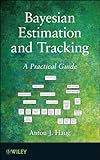Bayesian estimation and tracking : a practical guide.
By: Haug, Anton J.
Material type: BookPublisher: Hoboken : John Wiley & Sons, 2012Description: 1 online resource (523 pages).Content type: text Media type: computer Carrier type: online resourceISBN: 9781118287835; 1118287835; 9781118287798; 1118287797; 0470621702; 9780470621707; 9781118287804; 1118287800.Subject(s): Bayesian statistical decision theory | Automatic tracking -- Mathematics | Estimation theory | Mathematics | Bayesian statistical decision theory | Automatic tracking -- Mathematics | Estimation theory | MATHEMATICS -- Probability & Statistics -- Bayesian Analysis | Mathematics | Bayesian statistical decision theory | Automatic tracking / Mathematics | Estimation theoryGenre/Form: Electronic books.Additional physical formats: Print version:: Bayesian Estimation and Tracking : A Practical Guide.DDC classification: 519.5/42 | 519.542 Other classification: MAT029010 Online resources: Wiley Online Library
BookPublisher: Hoboken : John Wiley & Sons, 2012Description: 1 online resource (523 pages).Content type: text Media type: computer Carrier type: online resourceISBN: 9781118287835; 1118287835; 9781118287798; 1118287797; 0470621702; 9780470621707; 9781118287804; 1118287800.Subject(s): Bayesian statistical decision theory | Automatic tracking -- Mathematics | Estimation theory | Mathematics | Bayesian statistical decision theory | Automatic tracking -- Mathematics | Estimation theory | MATHEMATICS -- Probability & Statistics -- Bayesian Analysis | Mathematics | Bayesian statistical decision theory | Automatic tracking / Mathematics | Estimation theoryGenre/Form: Electronic books.Additional physical formats: Print version:: Bayesian Estimation and Tracking : A Practical Guide.DDC classification: 519.5/42 | 519.542 Other classification: MAT029010 Online resources: Wiley Online Library Cover; Title Page; Copyright; Dedication; Preface; Acknowledgments; List of Figures; List of Tables; Part I: Preliminaries; Chapter 1: Introduction; 1.1 Bayesian Inference; 1.2 Bayesian Hierarchy of Estimation Methods; 1.3 Scope of this Text; 1.4 Modeling and Simulation with Matlab®; References; Chapter 2: Preliminary Mathematical Concepts; 2.1 A Very Brief Overview of Matrix Linear Algebra; 2.2 Vector Point Generators; 2.3 Approximating Nonlinear Multidimensional Functions with Multidimensional Arguments; 2.4 Overview of Multivariate Statistics; References.
Chapter 3: General Concepts of Bayesian Estimation; 3.1 Bayesian Estimation; 3.2 Point Estimators; 3.3 Introduction to Recursive Bayesian Filtering of Probability Density Functions; 3.4 Introduction to Recursive Bayesian Estimation of the State Mean and Covariance; 3.5 Discussion of General Estimation Methods; References; Chapter 4: Case Studies: Preliminary Discussions; 4.1 The Overall Simulation/Estimation/Evaluation Process; 4.2 A Scenario Simulator for Tracking a Constant Velocity Target Through a DIFAR Buoy Field; 4.3 DIFAR Buoy Signal Processing; 4.4 The DIFAR Likelihood Function.
References; Part II: The Gaussian Assumption: A Family of Kalman Filter Estimators; Chapter 5: The Gaussian Noise Case: Multidimensional Integration of Gaussian-Weighted Distributions; 5.1 Summary of Important Results From Chapter 3; 5.2 Derivation of the Kalman Filter Correction (Update) Equations Revisited; 5.3 The General Bayesian Point Prediction Integrals for Gaussian Densities; References; Chapter 6: The Linear Class of Kalman Filters; 6.1 Linear Dynamic Models; 6.2 Linear Observation Models; 6.3 The Linear Kalman Filter; 6.4 Application of the LKF to DIFAR Buoy Bearing Estimation.
References; Chapter 7: The Analytical Linearization Class of Kalman Filters: The Extended Kalman Filter; 7.1 One-Dimensional Consideration; 7.2 Multidimensional Consideration; 7.3 An Alternate Derivation of the Multidimensional Covariance Prediction Equations; 7.4 Application of the EKF to the DIFAR Ship Tracking Case Study; References; Chapter 8: The Sigma Point Class: The Finite Difference Kalman Filter; 8.1 One-Dimensional Finite Difference Kalman Filter; 8.2 Multidimensional Finite Difference Kalman Filters.
8.3 An Alternate Derivation of the Multidimensional Finite Difference Covariance Prediction Equations; References; Chapter 9: The Sigma Point Class: The Unscented Kalman Filter; 9.1 Introduction to Monomial Cubature Integration Rules; 9.2 The Unscented Kalman Filter; 9.3 Application of the UKF to the DIFAR Ship Tracking Case Study; References; Chapter 10: The Sigma Point Class: The Spherical Simplex Kalman Filter; 10.1 One-Dimensional Spherical Simplex Sigma Points; 10.2 Two-Dimensional Spherical Simplex Sigma Points; 10.3 Higher Dimensional Spherical Simplex Sigma Points.
A practical approach to estimating and tracking dynamic systems in real-world applications. Much of the literature on performing estimation for non-Gaussian systems is short on practical methodology, while Gaussian methods often lack a cohesive derivation. Bayesian Estimation and Tracking addresses the gap in the field on both accounts, providing readers with a comprehensive overview of methods for estimating both linear and nonlinear dynamic systems driven by Gaussian and non-Gaussian noices. Featuring a unified approach to Bayesian estimation and tracking.
Print version record.



There are no comments for this item.